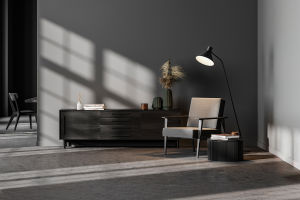Have you ever wondered why minimalist interior design has become so popular in modern homes?
If so, you're not alone! This design style, especially prevalent in today's home decoration scene, offers a refreshing approach to creating a functional yet aesthetically pleasing environment.
In this article, let's take a closer look at the defining features of the modern minimalist style and why it resonates with so many of us, especially young people.
What is Modern Minimalism?
At its core, modern minimalist style is about simplicity. It's all about focusing on what's essential and removing unnecessary elements. It's a style that emphasizes clean lines, open spaces, and functionality. In a minimalist space, the details are simple, yet thoughtful, with the focus on creating an atmosphere of calmness and balance.
As the world becomes more fast-paced, young people, in particular, are drawn to minimalist designs because of their ability to create an orderly, relaxed environment at home. After a busy day, having a space where everything feels organized and peaceful can be a breath of fresh air. The clean aesthetics help to ease the mind and provide a sense of tranquility.
Key Features of Modern Minimalist Style
The minimalist style incorporates several elements that make it stand out from other design styles.
Open Spaces and Free Flowing Design
One of the most significant aspects of minimalist interior design is the open, flowing space. The layout is designed to make the most of every corner, ensuring that the area feels spacious and unobstructed. Minimalist design does not like walls to confine spaces. Large windows are common to let in natural light, which creates a connection between the indoors and outdoors.
Simple Shapes and Pure Materials
Minimalism thrives on the idea of simplicity, and this is reflected in the choice of furniture, materials, and design. Clean, simple shapes are favored over intricate or overly decorative pieces. Materials like concrete, metal, wood, and glass are often used, and the focus is on their natural beauty and texture. The goal is to create an environment that feels refined, modern, and comfortable without being too busy or cluttered.
Emphasis on Functionality Over Ornamentation
When it comes to minimalist design, less is more. The focus is on the practicality of each item, with minimal decoration. Any unnecessary elements are avoided to keep the space neat and functional. The idea is that every design choice should have a purpose, either in form or function. This means that decorative features or elaborate designs are kept to a minimum to avoid clutter.
Furniture and Decor in Modern Minimalism
Minimalist furniture often has a sleek, clean design, focusing on straight lines and geometric shapes. Materials like metal, glass, and wood are used to create a balance of textures. These elements are typically used sparingly, with a focus on creating open spaces rather than overcrowding a room with furniture. The furnishings are carefully chosen for their practicality and aesthetic appeal.
Color Palette in Minimalism
The color palette in minimalist design tends to be neutral, often featuring whites, blacks, and grays, with occasional pops of color for accent. These colors create a clean, serene environment that allows other elements of the design to shine. However, the colors used in minimalist design are chosen for their ability to enhance the feeling of space and light, contributing to the overall calmness of the room.
The Evolution of Minimalist Style
Minimalist design originated in the early 20th century in Western modernism, particularly influenced by the Bauhaus school in Germany. Founded in 1919, the Bauhaus school emphasized functional design, mass production, and simplicity. Over the years, the minimalist movement has evolved, focusing on reducing decoration and simplifying design elements to achieve the highest level of efficiency and beauty. The minimalist style has proven to be timeless and adaptable, making it a favorite among modern designers.
In conclusion, the modern minimalist style is all about simplicity, function, and clarity. Whether in our homes or workplaces, it creates an atmosphere that promotes relaxation and clarity of mind. With clean lines, functional designs, and open spaces, this style offers a perfect balance between elegance and practicality.
For many of us, adopting minimalist design can be a way to declutter our minds and create a peaceful environment where we can unwind. If you're looking to refresh your space, why not give minimalist style a try? It might just be the perfect fit for your modern lifestyle.


